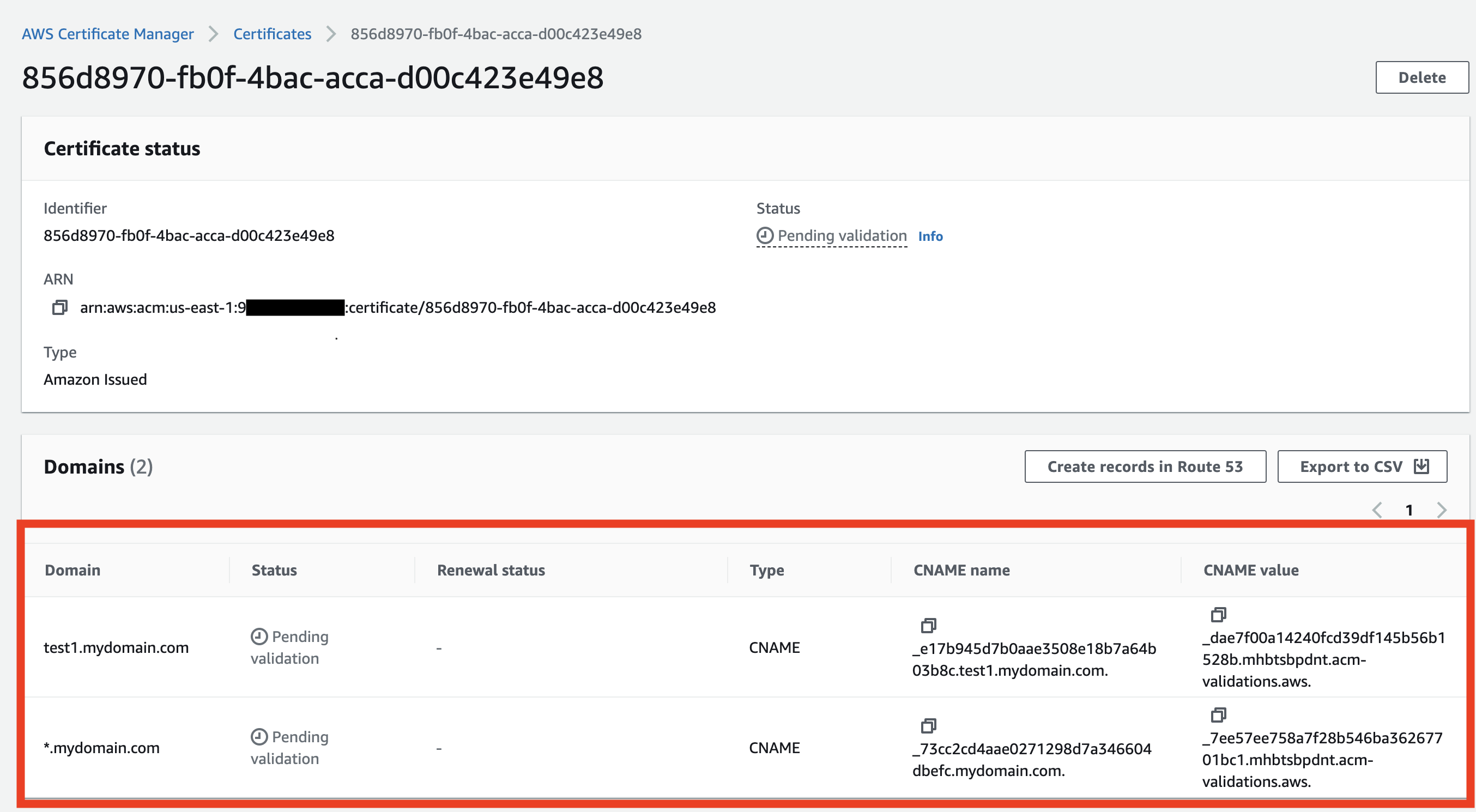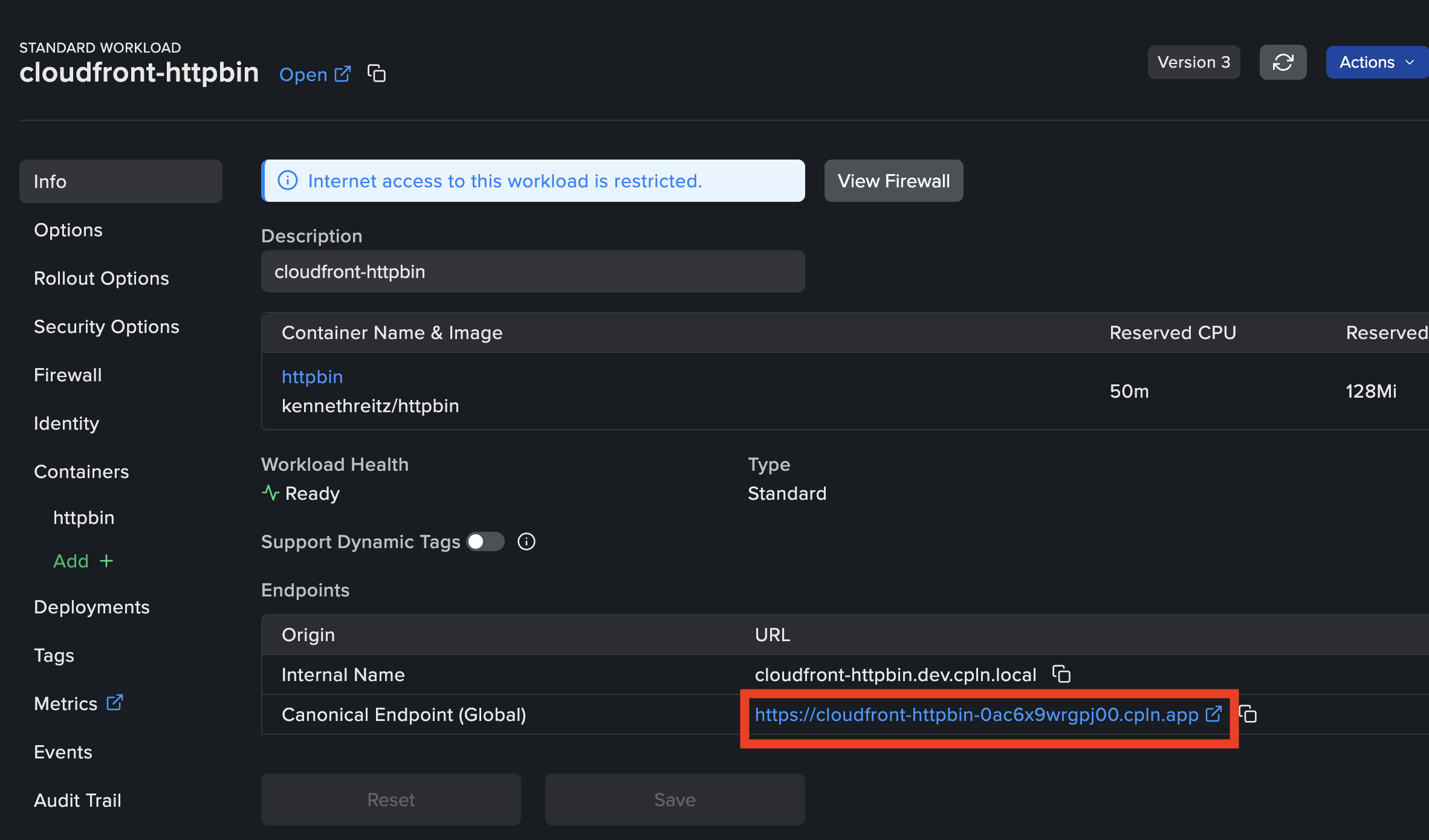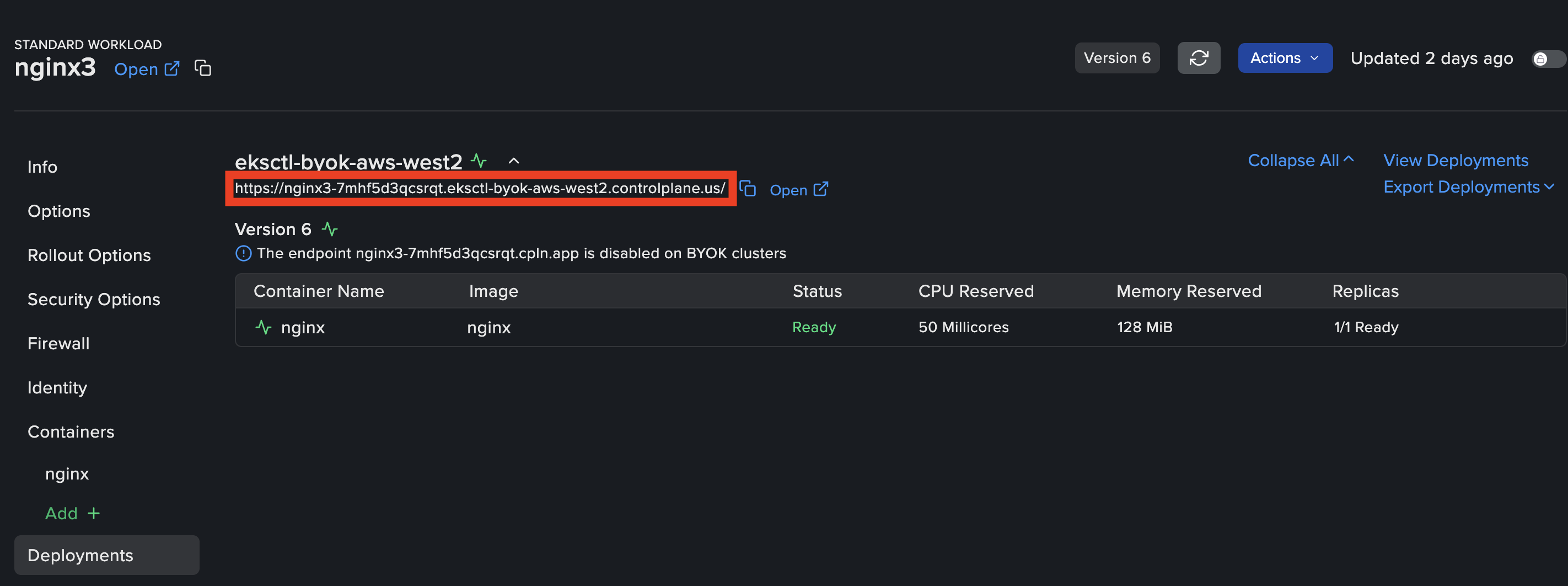Cloudflare Configuration Steps
Prerequisites
- Review the Configure a Domain guide.
- An account at Cloudflare.
- Your Domain’s DNS is hosted at Cloudflare.
- Your Workload is configured and in a
Readystate.
Step One - Domain Set Up and Certificate Generation at Cloudflare
From the Cloudflare UI, perform the following:Domain Set Up
- From the DNS management page for your domain, add a new
CNAMErecord.- For the
Namefield, enter the desired target subdomain. - For the
Targetfield, enter theCanonical EndpointURL from the Workload’s Info page. - Toggle on the
Proxiedswitch.
- For the
Certificate Generation Set Up
- From the SSL/TLS page, select the
Full (strict)radio box. - Click on the
Origin Serversubmenu link.- Create a new origin certificate for your domain with the following settings. This certificate will be added as a TLS Secret at Control Plane.
- Select
Generate private key and CSR with Cloudflare. - Select the Private key type:
RSA (2048). - The default list of hostnames shouldn’t have to be changed and will contain the
*.DOMAINandDOMAINhostnames. - Choose a long Certificate Validity such as 15 years.
- NOTE: It is your responsibility to ensure the certificate mapped to your domain at Control Plane is valid.
- Click
Create. The next page will display the certificate and private key. You may save these as separate text files or leave the page open and copy/paste the values when creating the TLS Secret at Control Plane in the next step.
- Select
- Create a new origin certificate for your domain with the following settings. This certificate will be added as a TLS Secret at Control Plane.
Step Two - Certificate Set Up at Control Plane
- Using the certificate and private key from the previous step, create a new TLS Secret at Control Plane by performing the following:
- Click
Secretsfrom the left side menu. - Click the
Newbutton at the top. - Enter a
Namefor the secret and select the secret typeTLS. - Either upload or paste the respective certificate and private key file in the proper textbox. The TLS Chain can be left empty since this certificate is self-signed.
- Click
Create. This secret will be used when configuring your domain in the next step.
- Click
Step Three - Domain Set Up at Control Plane(#step-3)
Follow the steps below to configure your Domain at Control Plane. Note: If a subdomain is being configured, the APEX domain will need to be verified.- Click
Domainsfrom the left side menu. - Click the
Newbutton at the top. - Enter the
Fully Qualified Domain Name (FQDN)of your Domain. - Click
Next (Spec). - Select
CNAMEfor theDNS Mode. - Select and configure the desired
Routing Mode. - Click the
Advanced Buttonbutton and Toggle on theConfigure TLSswitch. - Toggle on the
Use Custom Server Certificateand select the TLS Secret created in the step above. - Click
Next (DNS). - This page will display any DNS records that are required to be added for your domain. After adding the records, it will take a few minutes to propagate. Click the checkbox and click
Create.
After following the steps above, it will take a few minutes for the updates to propagate throughout the Internet.Once fully configured, your Workload will be accessible, via the CDN, using the subdomain configured in the first step.
Amazon CloudFront Configuration Steps
Prerequisites
- An AWS account.
- Access to edit DNS setting for your Domain.
- Your Workload is configured and in a
Readystate.
Step One - Request a public certificate
Request a public certificate with AWS Certificate Manager (ACM) inN. Virginia region using the setting below.
- A public TLS certificate is required for your domain. Use the following settings:
- Domain Names:
subdomain.mydomain.comor*.mydomain.com - Validation Method:
DNS Validation - Key Algorithm:
RSA 2048
- Domain Names:
The certificate must be in the US East (N. Virginia) Region (us-east-1).
- Access the newly created certificate on the ACM. Validate the certificate by creating the records in your DNS service as described.

Step Two - Create CloudFront distribution
-
Go to CloudFront distributions page and click on
Create Distribution -
Configure the
Origin Domainto the public endpoint of your workload. Use one of the following methods, depending on whether you are using a BYOK location or a managed locations (standard):-
For managed locations (standard) only:
Use the
Canonical EndpointURL from the Workload’s Info page asOrigin Domain, formatted as follows:cloudfront-httpbin-0ac6x9wrgpj00.cpln.app.
-
For BYOK locations only:
Locate the public endpoint on your Workload’s Deployments page. Use this address as the
Origin Domainvalue in CloudFront, formatted as follows:nginx3-7mhf5d3qcsrqt.eksctl-byok-aws-west2.controlplane.us.
-
For managed locations (standard) only:
Use the
-
Edit the
Alternate domain namefor your domain. In the format:subdomain.mydomain.com.
Then select theCustom SSL certificatecreated in Step one from the list.
-
You must select
Cache policyand complete the rest of the configuration as needed. -
Click on
Create distributionand wait for a few minutes to changes to apply.

Step Three - Configure DNS
Create a CNAME record in your DNS service (such as Route53), that will match the Alternate domain name in CloudFront distribution created in Step two:- Type: CNAME
- Name: nginx3
- Data: dddddddd.cloudfront.net
Step Four - Configuring Firewall to restrict access via CloudFront
- In order to ensure that it’s not possible to directly access the workload’s endpoint without going through the CloudFront CDN first, configure the firewall settings for the workload to allow ingress for CloudFront list of ip ranges. You can refer to this example workload YAML file and copy the CIDR range directly from this manifest.
-
BYOK Only: If you have created inbound rules on the Security Group of the Load Balancers, either directly or using the Actuator configuration INGRESS_FIREWALL_CIDR_LIST, you will need to update the Security Group configuration with CloudFront CIDR list range to enable CloudFront access to the workloads. Important: To support this setting, ensure that your quota for
Inbound or outbound rules per security groupunderAmazon Virtual Private Cloud (Amazon VPC)values for at least 530 rules. Visit Service Quotas in the AWS console for your region to request a quota increase if necessary.